Interactive Game:
A Playable Version of English Sixteen
Javascript is required to play this, make sure it is enabled in your browser. For reasons of both software-performance and convinience, it is contained on a page seperate from this one.
Tap or click on the glowing image below to open and play the game.
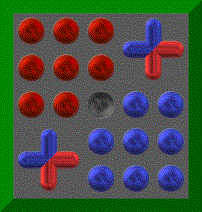
The interactive game contains rulesets for both English Sixteen and Fore and Aft, making it two games in one. If you are interested, please read the rest of this page for more infomation about them.
Introduction:
What is this Game?
English Sixteen is a solitaire game that is played using sixteen pegs and a special board.
Eight of the pegs must be light-colored and the other eight must be dark-colored—or any two colors the player prefers—and the board must have seventeen holes. The game is set up by placing one color of pegs in the first eight holes and the other color of pegs in the last eight holes—so that there is a single hole in the board's center. The holes on the board should be arranged in a way so that the first nine holes form a square shape and the last eight holes also form a nine-hole square by sharing the hole in its top-corner with the hole of the first square's bottom-corner. All the holes on the board should vaguely-resemble a diamond pointed bow-tie.
If a player is unable to win the game normally, they can leave pegs out of the board's fifth and thirteenth holes as a "practice mode" to familiarize themselves with the game's logic. This will result in a hole at the center of each set of pegs' initial square arrangement along with the original hole in the middle of the board. The game's rules remain unchanged and once the player fully understands how the game works, they may add back the pegs they removed for the full and proper challenge of English Sixteen.
Rules:
How is it played?
There are actually two set of rules for playing English Sixteen.
For this website, the older and less well-known ruleset is referred to as English Sixteen. It is described in this section.
The other ruleset is newer, simpler, and better well-known. The number of modifications it makes to the original is very small, and they are mentioned in the History section of this site. Even though these newer rules are significant for being the final major revision of English Sixteen to enter public memory, I have only included the original rules in this section because I think they work far better for defining the game's main principle.
The goal of the game is to swap all the pegs so that the light-colored pegs are where the dark-colored pegs were and all the dark-colored pegs are where the light-colored pegs were.
Pegs can only move in two different ways and not all pegs move in the same direction. On a turn, a peg can move into an adjacent hole or it can jump over another peg into a hole directly behind it.
Below is an animation showing how this works.

Each set of pegs can only ever move—or jump—in two possible directions. Pegs cannot jump or move diagonally, they can only move horizontally or vertically. Pegs which begin the game in the one section of the board can only move towards the opposite section.
Most boards tend to be labelled with compass directions to help with this, as well as for recording moves. If a color of pegs begins north and east of the initial empty hole then that color can only move south or west—the inverse is true for the other color of pegs.
Below is a table which shows the directions that the pegs used in the interactive game can move—when playing under this ruleset.
| Peg | Movement |
|---|---|
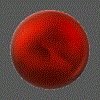 |
This peg can only jump/move south or east. |
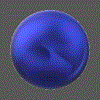 |
This peg can only jump/move north or west. |
The player is never allowed to move pegs backwards. If they get stuck and are unable to move pegs anymore and they haven't won yet, then they have lost the game. They must put all the pegs back to where they were at the start of the game in order to keep playing.
History:
Where does it come from?
If we want to get into the history of English Sixteen, we must first know what came before it.
The concept of peg solitaire is nothing new. People have been playing games by themselves using pegs and boards full of holes since the mid-to-late 17th century. However, these were games of elimination. All the pegs are identical and the only way they move is by jumping and capturing adjacent pegs, with the ultimate goal being to have one peg left on the board alone.
The first peg solitaire game of transposition was patented by one Ms. Anna B. Bullard on July the 5th, 1881, in the United States. The game in this patent (US243688A) has a board contained in a frog-themed box with a single row of seven spaces. It is set up by placing three dark and light pieces on the first and last three spaces of the board, so that there is only one free space left in the middle. Aside from this, the game uses the exact same rules as English Sixteen—minus the vertical axis.
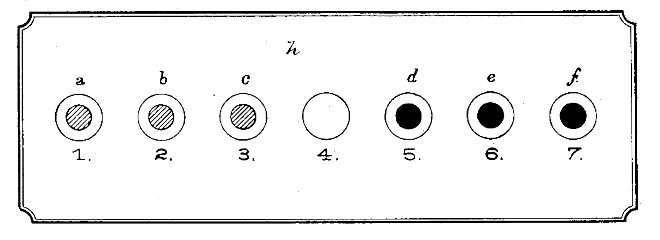
Even though several game-manufacturers made forms of Bullard's game throughout the 20th century, I will reduce discussion of it to only one notable edition as it isn't the main focus. Insanity is a design of the game with a ten hole board and four pegs on each side, so that there are two free spaces in the middle instead of one. This version of the game is notable because its existence is likely the only reason why Bullard's game hasn't fallen into the same oblivion as English Sixteen. It was cheaply mass-produced and sold by lots of distributors, and it's still being made today almost completely unchanged. The most widely-available copies of it come from a gift-set of wooden brain teasers that Cardinal Industries made between 1987 and sometime in the late 1990s.
Bullard's game is not very fun because it is extremely limited in terms of replayability, due to it only allowing one-dimension of movement. After a person solves it for the first time, they will always be able to easily solve it again and again because its solution becomes self-evident beyond the need for memorization. This is a problem that I think is mostly fixed with English Sixteen because of its addition of basic vertical movement allowed by the uniquely-shaped board. Bullard's game laid the foundation and English Sixteen moved it forward into the next dimension, a natural evolution which had to come sooner or later.
The first written reference to English Sixteen comes from the 1893 book Puzzles Old and New, written by Professor Hoffman—likely a pseudonym— and published by Frederick Warne and Co. It is featured in the book as Puzzle #26 (XXVI) in Chapter 6 (VI, "Puzzles with Counters"). The puzzle itself is on page 273 of the original edition and a solution for it is on page 287. This version of the game makes the board similar to a checkerboard by having the pieces sit on black squares and move diagonally.
There is another version of the game which was patented in the very next year—in the United States—by one Mr. Charles A. Emerson on July the 3rd, 1894. This version of the game (US522250A) has a layout very similar to what we have now, trading checkerboard squares for orthogonal numbered ones. Both of these versions use flat checker-like pieces, instead of colored pegs.
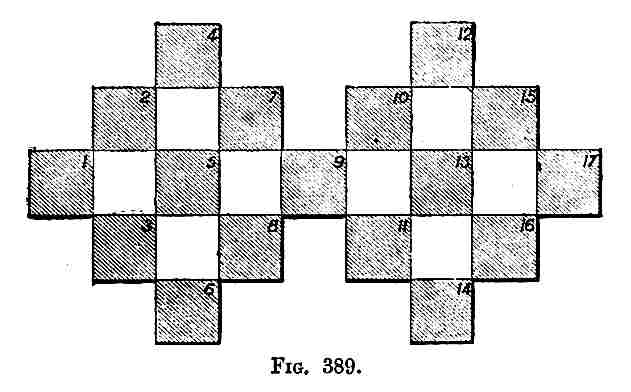

The first appearance of the game which has pegs, as far as I know, comes from Sam Lloyd's 1914 posthumous-book Sam Loyd's Cyclopedia of 5000 Puzzles. Here it is called "Fore and Aft". The difference between the version of the puzzle Sam describes and the other is that Sam allows pieces to move in any of the four cardinal directions, and not just two. This is to aid an additional goal of reaching the board's final swapped-state in the least moves possible, a kind of golf-score. He implies that each jump counts as one move.
Sam also adds a bit of backstory to the game, saying it was invented by an English fisherman who lived around Staten Island. According to Loyd, the fisherman would handcarve boards for the game with his pocket knife and sell them to tourists as a side-hustle.
His game eventually became popular in the UK but remained obscure in the US.
I cannot find any reference to the fisherman outside of Loyd's Cyclopedia so this story remains apocryphal. Below is the strange-looking illustration that was included of the seafarer and his puzzle.

Though this puzzle is almost completely unknown nowadays, at some point it was widespread enough that a few manufacturers produced their own versions of it. Most of them were based on Loyd's golf-scoring ruleset. The Set Screw & Manufacturing Company (Setko) made a nice wooden one in the 1960s—the first time as a promotional item with screws for pegs and the second time as a part of the Hoyle Official Games line of bookshelf puzzlers with high-quality, machined, pegs.
Stancraft Products—a subsidiary of Brown & Bigelow Incorporated at the time and of no relation to the boat company—was responsible for making the mahogany boards of the Hoyle line. It was under their name that these were published, only a small credit was given to Setko in the instructions. All of Setko's games before this were made entirely in-house.
The Venture Manufacturing Company from Dalton, Georgia, made their own version of the game in the 1970s as a part of their I.Q. Testers line of wooden peg games. These weren't nearly as prestigious as Setko's, being far closer in quality to those made by Cardinal Industries. Picture a board made from cheap plywood, markings silk-screened on it in black ink, and small injection-molded plastic pegs. Their game—called "Swap Squares"—does try to make up for this lack of quality by featuring a bizarrely-worded, and arguably pointless, scoring-chart to be used along with the golf-score.
I've transcribed it here as a table for anyone who might find it entertaining.
| Scoring | ||
|---|---|---|
| Over 40 Plays | Try Again | 0 Points |
| 36-40 Plays | Not Bad | 10 Points |
| 31-36 Plays | Smart | 25 Points |
| 25-30 Plays | Brilliant | 50 Points |
| Less Than 25 | ||
| Either you Miscounted Or You Are A Real Wizard — 100 Points | ||
I hope whoever wrote the text for these games got a raise. I am not clever enough to work out the math needed to find the shortest possible solution with free-moving pegs. The lowest score I've ever had when playing Fore and Aft is sixty. Sam Loyd said in his solution that some people have received scores as low as forty-seven. He includes this solution on page 353 of his book, though he doesn't specify which moves are jumps. I have no way of proving this but becoming a wizard might be impossible. To their benefit, Venture's board has a rule printed on it which says consecutive jumps count as one move. This is different from Sam Loyd's method and could change scoring dynamics considerably.
These versions of the game are pretty old—and thus hard to get a hold of. As of writing this, a company in Thailand which specializes in manufacturing wooden games—called SiamMandalay—makes their own version of the English Sixteen Game under the name "Battlefield". Battlefield comes bundled with the ruleset that says pegs can't go backward and does away with Sam Loyd's low-score goal, unlike the Setko and Venture versions. This same version of the game can also be found sold under the names of "Switch 8", "Changing 8", and "Switch 16".
In my opinion though, one cannot get the most possible fun out of this game unless they make their own set of pieces and board themselves.
Do-It-Yourself:
How can I make my own English Sixteen set?
Making your own English Sixteen set is extraordinarily easy.
The fastest way to make one is to section-off a part of a chessboard with masking-tape and use the pawns as pieces. One could even draw the board on a piece of paper and use bottlecaps or coins as the pegs.
However, these are far-away from being pretty and definitely not something I would want to leave on my coffee-table. Instead, I will explain here how one could make a pretty nice set out of wood—in only a few simple steps.
The first step is to find a suitable piece of wood to use as the board. For mine, I used a 4" x 6+1/3" x 2/3" piece of pine which I sanded down to not have any rough edges or surfaces. The next step is to draw the lines for the holes so they can be drilled in the right places. I recommend using a speed-square for this step and a straight-edge. A compass can be used instead of a speed-square, but that method is a lot trickier and more prone to error.
I know this because I spent five hours messing around with a compass before I realized everything was wrong, erased all the lines, and went and got a speed-square.
The first thing I did when I started drawing lines was approximating the center of the board and drawing a straight-line across it. Then I drew an X with the speed-square so that the center of it intersected with the middle line. After this, I drew a pair of margins on the edges of the board to get a rough-size and limit for the arrangement of holes. Then I drew a whole lot of criss-crossing lines until their intersections resembled that pointed bow-tie shape I mentioned earlier.
Here is a terrible diagram of everything I described, made in Microsoft Paint.
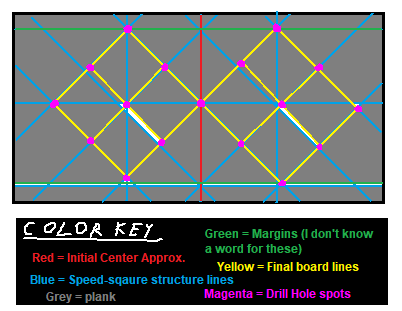
If you can understand how this works then congratulations, you think the same way I do. If you cannot understand how this works then I am very sorry about wasting your screen-space with this nonsense. Either way, you're going to have to Bob Ross the hell out of this for the holes to line-up properly.
If I actually bothered to write down my measurements then there would be a much better diagram on here. Unfortunately, I had to reverse engineer the lines I drew on the board from the final result and a five-month-old memory. This image is by no means accurate, it is only meant to give an idea of how to go about drawing the lines.
Everyone does things in a way they are comfortable with, this is what worked for me. Make sure you press very lightly with the pencil, otherwise the lines won't erase right and you'll have to sand the top of the board all-over-again after you finish drilling the holes, like I did.
Also—and this is really important—make sure there is enough space between the holes for you to comfortably pick-up and place the pegs in the board. I used regular sized golf-tees as pegs and there is at-least an inch between each hole.
When drilling the holes in the board, use a drill-bit that is only slightly-bigger than the pegs you plan on using with the board. The golf-tees I used were 5mm in diameter so I used a 6mm drill-bit. The goal is not to have the pegs get stuck in the board—nor is it for them to be so loose that they tilt. They should sit upright in the holes on the board, but if you were to flip the board upside-down, the pegs should easily fall out.
The board is basically finished after all the holes are drilled and the lines are erased/sanded-off. If one so-chooses, they can use a wood-burner to add lines across the holes and compass directions to make the pegs' allowed movement clearer, like I did with mine.
Here is what that looks like.
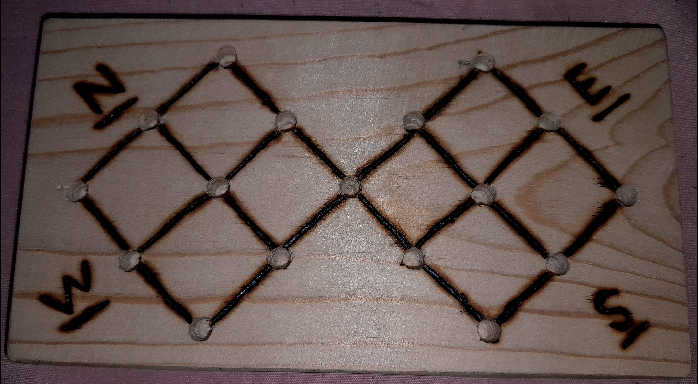
It works best if you have access to two types of peg which are distinct from each other in appearance but not functionality. All the golf-tees I had were white, so I painted the tops of them with acrylic. I chose the colors yellow and black because those colors make the pegs easy to instantly tell apart.
Here is what those looks like.

Finally, here is what the final game looks like altogether.
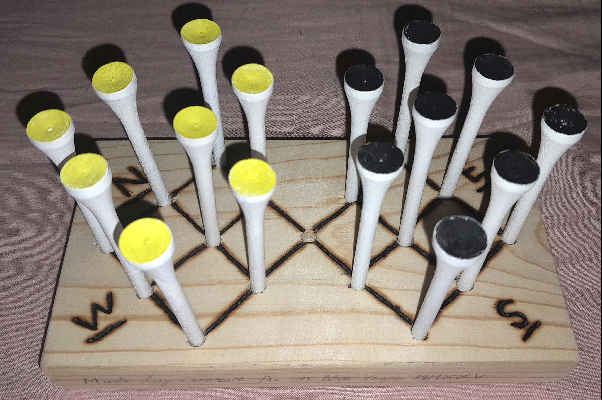
Overall, I think this is a neat little project for someone to do if they have several hours to kill or nothing planned for their weekend. Give it a try if you have the time, it's a lot of fun.
Variation:
How is Fore and Aft different from English Sixteen?
It is an understandable mistake to group these two rulesets together as the same game. They both use the same board and pieces, and they both have players working towards the same result by performing similar actions.
However, there are differences between them.
These can be found on an equally superficial level as similarities. One set of pegs in English Sixteen can only move in the opposite way of the other set. All pegs in Fore and Aft move the exact same way, regardless of their appearance or original position. Players must record each move they make in Fore and Aft, while English Sixteen requires no such obligation. A game of English Sixteen ends when all pegs cannot legally move. A game of Fore and Aft, in theory, could continue indefinitely. There are more though. If we look at each with a close eye and go beyond the surface, the differences run far deeper between them in a fundamental way.
Depending on one's perspective, English Sixteen is actually a puzzle instead of a game. This is because the player's interaction with it concludes when they make the board enter its final state. After the player figures out how to get all the pegs in the right place, there isn't much for them to improve on. Every time the player wins, the ruleset loses value in its challenge as their familiarity with it grows. They are not expected to come back to it.
This is where Fore and Aft changes English Sixteen from a puzzle into a proper game. By removing restrictions on the pegs' movement, it allows players to experiment with different strategies and arrangements without objectively knowing whether they are good or bad ideas. The point of Fore and Aft isn't to put the pegs in their correct places, but instead to discover the best way of doing so. Every game of Fore and Aft ends the same way—with the pegs being swapped. The only thing that changes is how the pegs are moved there by the player. Because of this, Fore and Aft is far more creative in its design. It adds replayability.
This also allows for potential—but mild—competition between players. They can compare scores, and see who did better as some would with games based on mechanisms of chance. Fore and Aft is capable of providing a social aspect which no other solitaire game of pure-skill can.
It is for these reasons I find it strange that more people don't know about either version of this game. It is a great twist on the old peg solitaire concept.
About:
Why does this site exist?
I first stumbled across Fore and Aft last year in 2024. In November, I was walking around the hobby and recreation section of my University's library when I found a newer edition of Sam Loyd's book. After I read through the foreword Martin Gardner wrote for it, I began flipping through its pages and the illustration of the fisherman holding the board immediately caught my eye. From the second I saw it, I knew I wanted to make my own copy of the game out of wood. And on New Year's day, a week or two after that semester's finals, I did. That project is what I took pictures of for the DIY section.
In between the time of me learning about the game from Loyd's book and me making my own copy, I amassed a considerable amount of information about it in one of my notebooks. It seemed pointless to keep it to myself, especially considering how few decent resources about this game exist on the internet. I do not consider this site to be a decent resource—but it is better than nothing. Maybe it will bring the game to someone else's attention and they'll know something more about it and throw their two-cents into the big liquid palimpsest that is the World-Wide-Web.
Or maybe this site will just entertain a handful of people and become an in-joke among their circles of friends.
Either way, I consider it a win.
I've also been wanting to make an interactive game out of English Sixteen for a while. This site became the perfect excuse to do that. Making the chunky pre-rendered 3D graphics was the best part.
I personally prefer the original ruleset, but both it and the score-keeping versions are fantastic games which more people should know about. The only reason I prefer the original is because, when playing in real-life, keeping track of moves with pen and paper gets tedious. Thank you for reading this.
Have a good day.
Links:
Where can I find more information about the game?
Here are some places I mentioned with information about the English Sixteen game.
- Entry in Professor Hoffman's book, hosted on the Internet Archive:
https://archive.org/details/puzzlesoldnew00hoff/page/272/mode/2up - Entry in Sam Loyd's book, hosted on the Internet Archive:
https://archive.org/details/CyclopediaOfPuzzlesLoyd/page/n55/mode/1up - Anna Bullard's patent, hosted on EspaceNET:
https://worldwide.espacenet.com/patent/search/family/002313017/publication/US243688A?q=US243688A - Charles Emerson's patent, hosted on EspaceNET:
https://worldwide.espacenet.com/patent/search/family/002591045/publication/US522250A?q=US522250A - Anna Bullard's patent, hosted on Google Patents:
https://patents.google.com/patent/US243688A/en?oq=US243688A - Charles Emerson's patent, hosted on Google Patents:
https://patents.google.com/patent/US522250A/en?oq=US522250A
